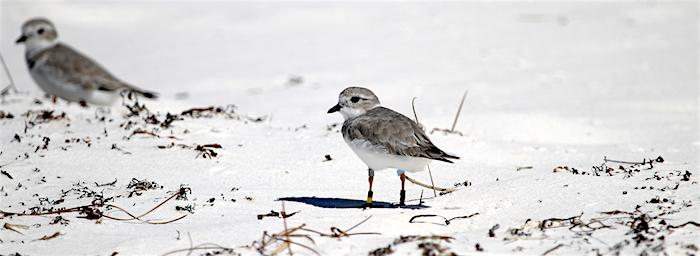
Piping plovers soon will be arriving at Gulf Islands National Seashore to winter/NPS
In preparation for the arrival of migratory piping plovers, Gulf Islands National Seashore staff in Florida has identified two important habitat areas for shorebirds. One is near Fort Pickens, and the other near Santa Rosa.
The federally protected piping plover, a small, stocky sand-colored bird with orange legs, frequently favors the sand beaches and flats of national seashore for foraging grounds. While piping plovers do not nest at Gulf Islands, the pristine habitat of the national seashore is a favorite location for the winter months.
Through partnerships with the U.S. Fish and Wildlife Service and Audubon Florida, an area at the tip of the Fort Pickens Area and one along the north shoreline of the Santa Rosa Area will be posted to protect piping plovers. The park does not anticipate any impact to beach combing, wading, or shore fishing. The areas will be signed and the public is asked to avoid walking through these areas.
Biologists at Gulf Islands have partnered with other scientists performing range-wide banding efforts that help identify and track the habits of piping plovers. By placing tiny colored bracelet-like bands on the legs of the birds, biologists can learn specific information about individuals. In one case, a 20-day old chick that was banded at a housing development in Nebraska was observed the next year nesting in North Dakota and was observed on various occasions in the non-breeding season at Fort Pickens and Perdido Key.
“In just this one instance, a single bird traveled about 1,300 miles to winter here in the seashore. These birds are Florida’s original snowbirds,” Superintendent Dan Brown said.
Studies have shown human disturbances on non-breeding grounds can have negative impacts to piping plovers.
“We try to stress the importance of the seashore as essential habitat for all types of wildlife and migratory birds. Small changes in how we use a beach can really add up to substantial improvements in the quality of habitat for shorebirds,” Brown added.
Piping plovers are migratory birds that in winter head to warmer climates of the southern Atlantic and Gulf coasts, including the sand flats of Gulf Islands National Seashore.



Comments
Just another attempt at taking away public acess to federal land.
Except for one thing, John. The closed areas consist of a very, very small percentage of the entire area. And even these areas are not closed completely. Visitors are asked to "avoid" walking through them, and are asked to use great care if they choose to do so.
A slightly more careful reading of the article above shows that "The park does not anticipate any impact to beach combing, wading, or shore fishing. The areas will be signed and the public is asked to avoid walking through these areas."